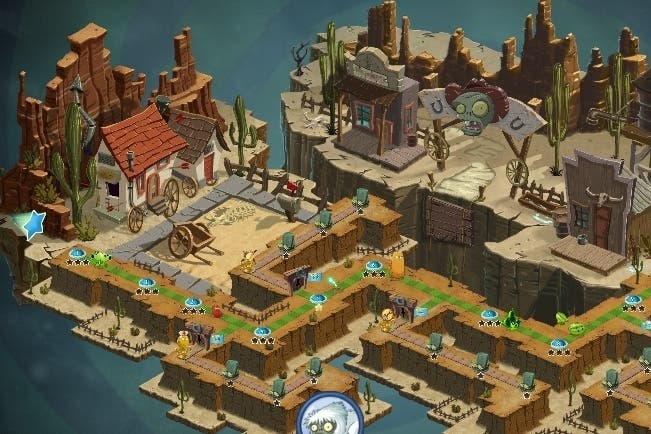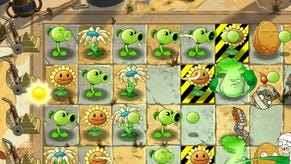How Plants vs. Zombies 2 works as a free-to-play game so far
Fruit and wedge?
Plants vs. Zombies 2 launched last week on the Australian and New Zealand App Stores, and I've been playing it over the last few days. Since this is a soft launch, however, it feels safe to assume that EA is still doing the final balancing on this free-to-play game's monetised elements before the rest of the world gets to try it out. Rather than go straight to a review, then, we thought it would be best to provide a sense of where the game is at the moment, with a particular eye on how the new business model affects the overall design. The basic structure of this tower-defence sequel presumably isn't going to change that much in the weeks that follow, but the vital details of its economy and how that affects the flow of the missions just might.
Currently, it feels like a surprisingly generous implementation of the new approach to payment. It's still a clever action-orientated spin on tower defence, continuing to dial up the immediacy while losing little of the genre's depth. And the game's main concessions to free-to-play mechanics don't lie with the fact that a handful of specific plant types are kept behind a micro-transaction paywall - although it's a shame that treats like the Squash, the Snow Pea and the Jalapeno are hived off like this - but with the addition of a series of boosts and one-shot power-ups, and in a new progression structure.
Let's look at the structure first. Plants vs. Zombies 2 sends you racing across time and space as Crazy Dave leaps through history to try and re-eat a taco that he's already consumed in the present. Each of the game's three worlds are based on a different period, although with ancient Egyptians, comedy pirates and ornery cowboys on the menu (more areas should follow, with a fourth already being teased), this is hardly Time Team. The art team takes this conceit and really runs with it; from the swashbuckling munchkins who launch themselves at you from cannons, to the mummified zombies who trail toilet roll behind them as they shamble around, it's a pleasure to look at.
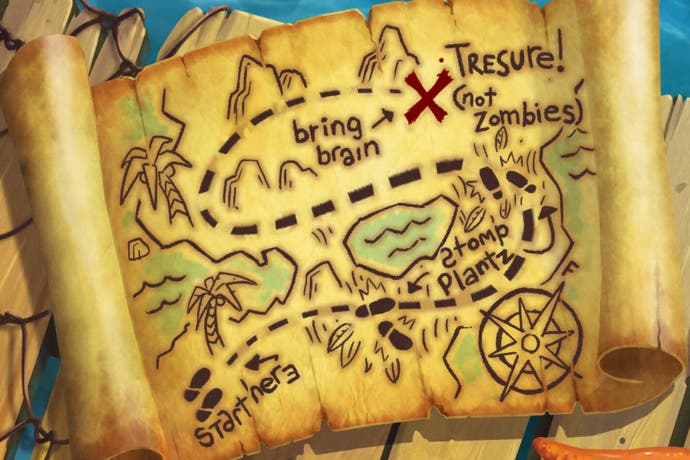
"The basic structure of this tower-defence sequel presumably isn't going to change that much in the weeks that follow, but the vital details of its economy and how that affects the flow of the missions just might."
Rather than hinging on the completion of 10 main campaign missions for each world, progression depends upon you then going back over those missions to finish a series of star challenges, which generally come down to replaying a set level with a range of energising restrictions - not letting the zombies advance past a certain point on the map, say, or not placing more than a dozen plants down at any one time. You'll need to earn 10 stars to unlock the second world, and a further 15 of them to unlock the final world - or Australians and New Zealanders can pay a couple of real-world dollars to advance instead.
Plants vs. Zombies 2 is much more challenging than the first game across the board, but some of these star missions are really tricky to complete. Luckily, at the moment they still exist within a difficulty range where they feel not just fair but fun with it: they push the tactical side of the series to its limit, which is something the original Plants vs. Zombies rarely tried to, and they encourage you to find new groupings of units that work in interesting ways. On top of that, there's a decent range of star missions to aim for within each world, so if you get stuck on the third tier of star runs with a specific map, you can just try the first tier on another. Or you can collect a series of keys within each level, which opens up optional routes, all of which will grant you an extra item and a few more star missions to choose from.
This is how a lot of the game's plants are introduced into the campaign, alongside perks like an extra seed slot (you start with six) or a boost that allows you to start with more of the sunlight you spend during levels. The keys you'll need are randomly dropped by enemies within the levels you play, or you can once again pay a few dollars in real-world money to skip all that. As with the star missions, this currently feels pretty generously balanced: I got to the end of the game without paying anything, which is handy as I don't have a New Zealand bank account to hand, and I had earned just enough keys to open up everything I was after.
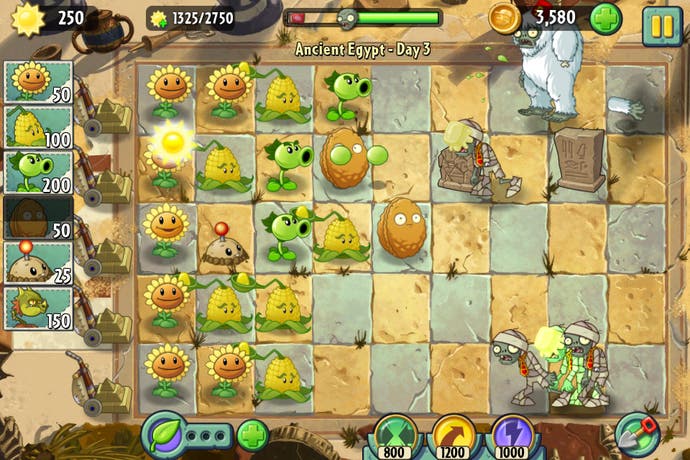
The new structure's a little grindy, but the only real twist on the formula is that a series of harder missions that would presumably have been left to your own discretion in a game that you bought outright are mandatory now that the game is free. You're paying either to cut out some of the missions, which sounds a little weird when the basics are still this entertaining, or, more likely, to tackle them at your own pace.
Meanwhile, on a moment-to-moment level, individual stages are enlivened by the addition of boosts and power-ups. The boosts come in the form of plant food, which can be dropped on a unit to improve its performance for a short period of time. Drop it on a Kernel Pult, and it will lob butter at every enemy on the map, for example, while a Peashooter will turn into a machine-gun for a few glorious seconds, and even the stoical old Potato Mine will fire off another mine to a random empty tile. Power-ups allow you to control the action in an even more hands-on manner, triggering quick countdown sequences in which you can either pinch enemies to crush their heads, prod them to zap them with electricity, or swipe them to gust them into the air and then blow them off the map for good.
Power-ups in particular are game-changingly effective and, if used correctly, can take you from near-defeat to an empty playing field in less than three seconds. They ultimately feel like cheating. Like the unlock structure, I suspect they wouldn't be implemented in quite this manner in a game that had a different payment model, but even if they're OP at the moment, they're balanced on the financial side of things to allow players to work their way through the campaign for the most part without paying and without needing to use them that often.
Both plant food and power-ups are bought with in-game coins, which are often dropped on the map by defeated enemies, and plant food even spawns three or four times a level when you finish off a specific foe. With the soft launch build as it stands, I was able to harvest all the coins I needed during the easier main mission campaigns and then rely a little more on plant food during those star challenges. It's a bit of a faff at times, but it's a very gentle form of monetisation. It will be interesting to see whether that gentle nature survives into the global launch period.

At times, in fact, it can be a little hard to see where the real money's going to come from in the current version: the in-game economy is generous, progress is challenging without being anywhere near nightmarish enough to see you busting out the wallet, and while you can pay to move things along a little quicker and pay to buy bundles of coins ranging from 5000 for $4.19 (just over £2.00) to 100,000 for $38.99 (just over £20.00) - and presumably you'll be paying for any new worlds that are introduced as well - the most tempting things in the shops are those plant packs for old favourites that don't turn up in the main campaign. (They're a little pricey at $4.19, although they're available in bundles with a cheaper selection of upgrades.)
"The fresh plants slot in alongside the existing units extremely well. The Lightning Reed, Bonk Cho and Bloomerang all feel like classics in the making."
If the game's rather restrained in its approach to the free-to-play model at the moment, then, it's also fairly conservative in its general approach as a sequel. Collect sunlight, arrange some largely fairly familiar turrets, fight off carefully arranged hordes of the undead before they get to your lawnmower defensive line: the basics still work beautifully, and Plants vs. Zombies 2 doesn't take enormous risks with the template laid down by the original.
Most of the designers' creativity is visible in a handful of new plant types unlocked during the campaign and a range of themed zombies that are encountered as you move through history. The fresh plants slot in alongside the existing units extremely well, with the likes of the Lightning Reed providing an electrical turret that can arc damage between enemies, a Bonk Choy that delivers melee attacks regardless of whether an enemy is in front of it or behind it, and the Bloomerang that sends out projectiles which hit enemies on the way out and the way back. All three feel like classics in the making. Crazier additions include a Coconut Cannon that does massive damage but has a lengthy recharge, and the Snapdragon, which breathes flames across three lanes but has limited range: they pay for their excesses with serious shortcomings, as they should.
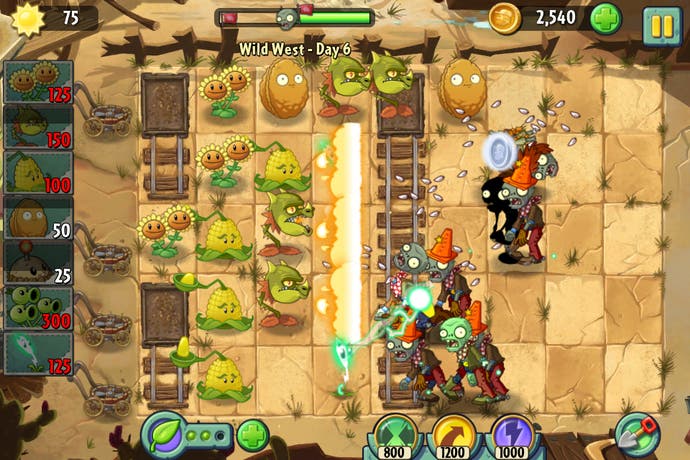
Elsewhere, lesser new recruits include a Power Lily that produces plant food (you'll need to spend real-world cash to unlock this guy), an Iceberg Lettuce, which is basically a low-cost freeze mine, and a Chili Bean, that causes zombies to vent paralysing gas. New enemy types differ as you move from one zone to the next: Egypt features armoured foes, a sunlight thief and courses filled with projectile-blocking tombstones, while pirates will swing across gaps and attack with parrots, and Wild West levels feature minecart tracks you can move units around with and enemies that leap behind you and then work their way back through your ranks. Beyond that, there's the odd mission that mixes things up by limiting your economy, giving you specific sequences of units, or even riffing on shape-matching mechanics, and a challenge mode for each world that has you facing off against increasingly hostile waves of the undead.
It's hard not to wonder what George Fan, the creator of the original game, would have done with a sequel, just as it's almost inevitable when a beloved series goes free-to-play that you find yourself questioning things a bit more than usual - whether a certain level is now artificially difficult, or whether a power-up is a little too effective. When balancing in a free-to-play game goes wrong, as with Real Racing 3, there's a definite sense that the developers are working to two masters. They're trying to entertain you, the player, but they're also trying to infuriate you towards buying the bits and pieces that will ultimately allow the game to be profitable. At its worst, this kind of thing can take the relationship between player and designer and make it rather oppositional.
Plants vs. Zombies 2 doesn't feel like that at the moment. You could wish for a few more new ideas, perhaps, but New Zealand and Australia are currently enjoying an entertaining and generous sequel with a nice weighting to its economy. Hopefully it will still have all of that when it launches globally.
